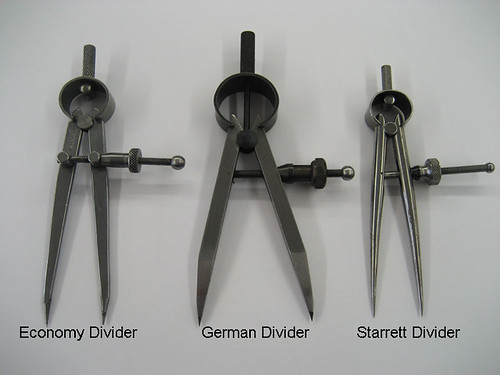Tool of the Month:
Divider
Divider
This month I am kicking off a series on precision tools, beginning with the divider. Although, a lot of us don’t like to say what we do is precise or measured. A lot of the time, no matter how organic or random the design, jewelry really is tedious and precise. From setting stones to measuring the size of a ring, jewelry-making is an exact procedure.
Dividers, often called spring dividers, spring calipers and divider calipers, are a style of caliper. Calipers are a kind of device used to measure the distance between two opposing sides. The tips of the caliper are adjusted to fit across the points to be measured, the caliper is then removed and the distance read by measuring between the tips with a measuring tool, such as a ruler. While a divider can measure distance, it is most often used to mark metal. The divider has two sharpened legs held in tension with a spring with a threaded rod that controls the distance between the tips.
When I first learned of dividers, I was in a jewelry class at Spruill and I was thoroughly confused by the name. I did recognize the tool but I knew it as a compass from my trigonometry class in high school. Or was it geometry? I don’t remember, but it was a math class none the less!
Unlike my compass with a steel pointed
 end and a pencil on the other, the divider had two steel pointed ends. My confusion continued as we used the tool, not to draw a circle, but to draw a straight line. Using a small steel ruler to find the exact width, the divider was set and locked into that distance. Guiding along the edge of the metal with one side of the divider, a precisely measures parallel line was lightly scribed into the surface of the metal. The line was then used to guide the saw blade along and cut (to the best of your ability) a straight line. AND if your sawing skills weren’t quite straight the lightly scribed line was still there to use as a guide to file away excess metal. INGENIOUS! No more using a ruler to make small tick marks in pencil/pen/sharpie that are hopefully parallel to then draw a (cross your fingers) straight line. Which then you will saw along the straight line only to find your sweaty fingers from the nerve-wrackingly tedious procedure, has wiped away your line!
end and a pencil on the other, the divider had two steel pointed ends. My confusion continued as we used the tool, not to draw a circle, but to draw a straight line. Using a small steel ruler to find the exact width, the divider was set and locked into that distance. Guiding along the edge of the metal with one side of the divider, a precisely measures parallel line was lightly scribed into the surface of the metal. The line was then used to guide the saw blade along and cut (to the best of your ability) a straight line. AND if your sawing skills weren’t quite straight the lightly scribed line was still there to use as a guide to file away excess metal. INGENIOUS! No more using a ruler to make small tick marks in pencil/pen/sharpie that are hopefully parallel to then draw a (cross your fingers) straight line. Which then you will saw along the straight line only to find your sweaty fingers from the nerve-wrackingly tedious procedure, has wiped away your line!Dividers have multitudes of other uses:
- quickly measuring the size of a bur compared to the size of a stone
- finding center on a circle
- drawing a precise circle
- drawing layouts with arcs
- holding a measurement
- creating a grid pattern for tight stone setting, i.e. pavé
- scribing a straight line on round wire
- compare sizes from one object to another
- drawing a straight line for layout when stamping
- marking lines for mitered corners on boxes and settings
- layout for wax work
- inscribing a line as a guide for filing
JFF carries three choices for dividers, while they are all 3”, their price, quality, and leg size set them apart. The economy divider is made Indian made. The stainless steel legs are thin and rectangular at the top and round down to a small point at the tip. The economy divider has a small adjustment wheel to lock the legs in place. They are $6.95, making them the perfect option for a beginner metalsmith.
The German made dividers are a very sturdy square leg construction, made of tool steel. They have a smoother action adjustment than the economy divider. However the legs are quite wide and bulky causing them less useful in tight spaces. However, the German divider has a quick change feature unique to itself. When tension is released from the setting wheel, the legs can be quickly adjusted to the approximate position desired. The setting wheel can then be slid back into place for fine tuning and locking the legs into the precise location. These dividers are $11.25.
The Starrett is an American made, tool steel divider. Starrett is known for their quality precision tools, and this 3” divider is proof. The finish on the thin, round legs is top notch. The fully round legs lend themselves to many small applications. They are especially great for wax work, as the legs will not scrape the wax as the square legs will. They also have a smooth action adjustment with no wobble and the legs line up true when fully together. The Starrett dividers are $54.15.




No comments:
Post a Comment